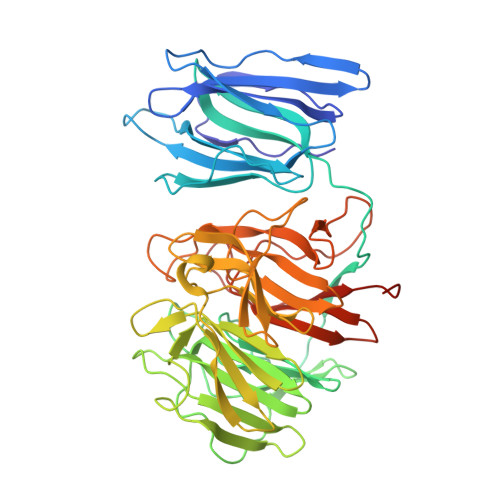Crystal structure of the nitrile-specifier protein NSP1 from Arabidopsis thaliana
Zhang, W., Zhou, Y., Wang, K., Dong, Y., Wang, W., Feng, Y.(2017) Biochem Biophys Res Commun 488: 147-152
- PubMed: 28479247
- DOI: https://doi.org/10.1016/j.bbrc.2017.05.027
- Primary Citation of Related Structures:
5GQT - PubMed Abstract:
As important components of the glucosinolate-myrosinase system, specifier proteins mediate plant defense against herbivory and pathogen attacks. After tissue disruption, glucosinolates are hydrolyzed by myrosinases to instable aglucones, which will rearrange to form defensive isothiocyanates. Nevertheless, this reaction could be redirected to form other products by specifier proteins. Up to now, identified specifier proteins include epithiospecifier proteins (ESPs), thiocyanate forming proteins (TFPs), and nitrile-specifier proteins (NSPs). Recently, the structures of ESP and TFP have been reported. However, both the structure and the catalytic mechanism of NSPs remain enigmatic. Here, we solved the crystal structure of the NSP1 protein from Arabidopsis thaliana (AtNSP1). Structural comparisons with ESP and TFP proteins revealed several structural features of AtNSP1 different from those of the two proteins. Subsequent molecular docking studies showed that the R292 residue in AtNSP1 displayed a conformation different from those of the corresponding residues in ESP and TFP proteins, which might account for the product specificity and catalytic mechanism of AtNSP1. Taken together, the present study provides important insights into the molecular mechanisms underlying the different product spectrums between NSPs and the other two types of specifier proteins, and shed light on the future studies of the detailed mechanisms of other specifier proteins.
- Beijing Key Lab of Bioprocess, Beijing University of Chemical Technology, Beijing 100029, PR China.
Organizational Affiliation:
















